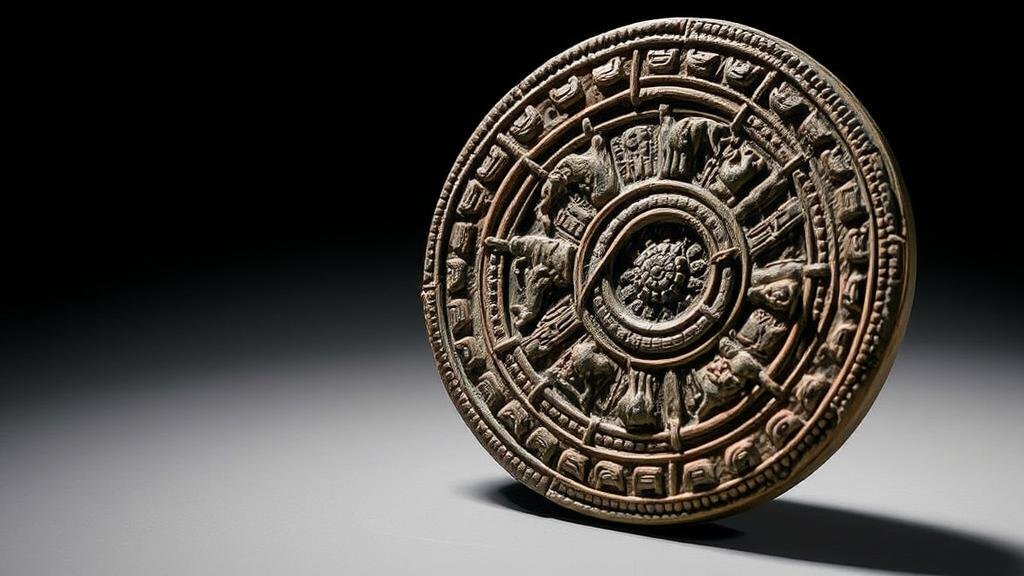Unraveling the mystery of the Phaistos Disc, an undeciphered artifact from ancient Crete.
Unraveling the Mystery of the Phaistos Disc
The Phaistos Disc, a perplexing artifact discovered on the island of Crete, stands as one of archaeologys greatest mysteries. Unearthed in 1908 by the Italian archaeologist Luigi Pernier during excavations at the Minoan palace complex of Phaistos, this clay disc features symbols that remain undeciphered despite numerous attempts by scholars and cryptographers. The disc dates back to approximately 1700 BCE, placing it within the sophisticated Minoan civilization known for its advanced writing systems and artistic achievements.
A Closer Look at the Artifact
The Phaistos Disc is approximately 15 centimeters (5.9 inches) in diameter and is made of fired clay. Its surface is inscribed with 241 symbols organized in a spiral pattern, depicting a variety of images including human figures, animals, plants, and tools. These symbols have led to multiple interpretations regarding their meanings, ranging from religious or ritualistic significance to practical usages like inventory or record-keeping.
The Historical Context of the Minoan Civilization
The Minoans, who inhabited Crete from around 2700 to 1450 BCE, are renowned for their contributions to early European culture. They established a commodious trade network, establishing connections with other ancient civilizations such as Egypt and Mesopotamia. unearthing of the Phaistos Disc suggests a level of sophistication in symbolic communication that may have influenced subsequent writing systems.
Theories Surrounding Its Purpose
Several theories attempt to explain the purpose of the Phaistos Disc. The following are the most prominent:
- Religious Artifact: Some researchers propose that the disc may have served a ceremonial or religious function, perhaps as an offering or as part of a ritual.
- Game Board: A less conventional theory suggests it might have functioned as a board game, with the symbols representing different moves or types of play.
- Early Writing System: The most widely accepted theory is that the disc represents an early form of writing, similar to linear A, used by the Minoans. This writing could indicate trade transactions or record-keeping.
The Difficulties of Deciphering the Disc
Deciphering the Phaistos Disc has proven exceedingly challenging due to several factors:
- Lack of Context: Unlike the Rosetta Stone, which provided a clear basis for translations, the Phaistos Disc lacks bilingual inscriptions or sufficient contextual references.
- Unique Symbols: The symbols on the disc do not correlate directly with known writing systems, leading to ambiguity in interpretation.
- Few Comparisons: With limited examples of similar inscriptions available, establishing a comprehensive understanding is complicated.
Real-World Implications and Research
The mystery surrounding the Phaistos Disc not only captivates researchers but also evokes a sense of wonder about the capabilities of ancient civilizations. Recent advancements in digital technology and computer analysis have opened new avenues for studying this artifact. For example, machine learning algorithms developed to analyze the symbols in attempts to identify patterns that human scholars may overlook.
Conclusion and Actionable Takeaways
While the true purpose and meaning of the Phaistos Disc remain elusive, this artifact serves as a reminder of the intricate history of written communication and the complexities of human civilization. Individuals interested in archaeology or ancient history can take the following actions:
- Engage with academic literature on Minoan civilization and writing systems.
- Participate in or follow current archaeological excavations in Crete to gain insights into new findings.
- Explore technological advances in deciphering ancient scripts and consider how they might apply to the Phaistos Disc.
As researchers continue their quest to unlock the secrets of the Phaistos Disc, one thing remains certain: this enigmatic artifact will continue to inspire curiosity and investigation for generations to come.


